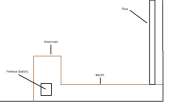posted 6 years ago
Welcome!
Cob when wet pretty much reverts to mud with some straw in it.
When reading about building with it you will hear again and again about the need for good 'boots, hat, and coat'; dry raised foundation/stemwall, good roof overhangs, and tough plaster or siding, all to keep the cob dry.
Unless you are somewhere really, really, really dry, this plan as it stands is probably a nonstarter...
'Theoretically this level of creeping Orwellian dynamics should ramp up our awareness, but what happens instead is that each alert becomes less and less effective because we're incredibly stupid.' - Jerry Holkins







